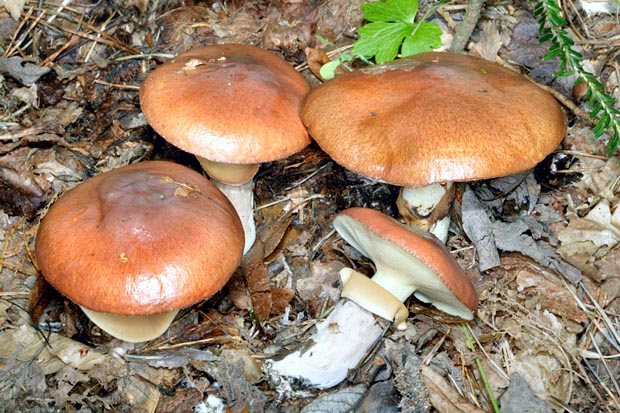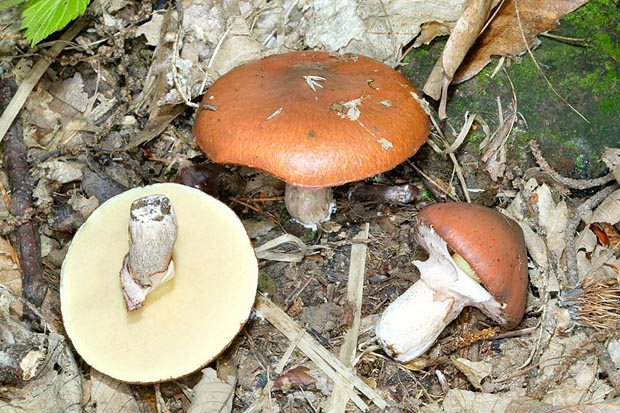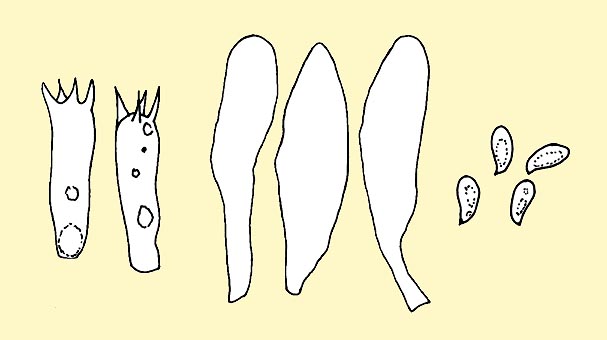
Text © Pierluigi Angeli

English translation by Mario Beltramini

The Suillus luteus is an edible fungus quite common under the conifers © Giuseppe Mazza
Family: Suillaceae (Singer) Besl & Bresinsky, 1997.
Section: Suillus (= Sez. Granulati Singer p.p.).
Genus: Suillus Micheli ex Adanson, 1763.
Suillus luteus (L. : Fr.) Roussel, 1806.
The name comes from the Latin “lútum”, which means “grass that tinges with yellow”. The fungus is known also with the current names “slippery Jack”, “sticky bun” in English-speaking countries; “pinerolo”, “pinuzzo”, “boleto giallo” in Italy; “bolet jaune”, “nonnette voilée” in France; “boleto anillado”, “boleto viscoso anillado”, “pinetell”, “ molleric de calceta”, “pinudi-onddo likin” in Spain.
Description of the genus
To the genus belong medium or medium-big sized fungi, with the pileic cuticle completely removable, or in flaps, from the underlying flesh, from viscid to slimy with wet weather, otherwise smooth or scaly or floccose.
The hymenophore is formed by adnate tubules, decurrent adnate or definitely decurrent. The stem is cylindroid, with or without ring (residual of the partial veil), with or without granulations decorating its surface. The spores in mass are ochraceous brown, from ellipsoidal to fusiform; cystidia and caulocystidia are claviform, fasciculate, at times with resinous encrustations. Its habitat is under conifers (Pinus nigra, Pinus sylvestris, Pinus pinaster, etc.).
To the Section Suillus are ascribed fungi having stem with or without ring (remnants of the partial veil), with granulations, with small pores.

The cap rarely exceeds the 10 cm and may be deemed covered by chocolate glaze © Giuseppe Mazza
Description of the species
Cap: 4-10 (15) cm, initially hemispheric, then convex, pillow-shaped, edge curved downwards, regular, often decorated by remnants of the partial veil. The cuticle is just exceeding the tubules, detachable, smooth, and slimy, of brown, brown-yellow, chocolate-brown colour, with darker radial fibrils.
Hymenium: average long tubules, adnate or slightly decurrent, initially yellow, then buff-yellow. Tiny pores, rounded, angular when fully ripe, yellow, at the end olive, immutable.
Stem: 4-8 x 1,5-3 cm, stocky then slender, cylindrical, enlarged towards the base, full, of yellow colour, decorated by yellow granulations becoming later brown, in the part over the ring, under it has some longitudinal fibrils darkening with the time and becoming concolorous to the cap. The ring is membranous, large, whitish, then violaceous-grey, quite often found adherent to the stem.
Flesh: initially firm, then soft, watery, fibrous in the stem, whitish, yellow under the cuticle and in the zones near the hymenium. Fruity smell, sweet taste.
Habitat: it grows by late summer and in autumn in the pinewoods, especially under two needled pines.
Edibility: edible.
Spores: ellipsoidal, fusiform, smooth, guttulated, with thick wall, 7-9,5 × 3-3,5 µm, Q = 2,4.

Suillus luteus basidia, cystidia and spores © Pierluigi Angeli
Basidia: clavate, tetrasporic, without joint buckles, 22-27 × 6,5-7 µm.
Cystidia: clavate, cylindrical, 35-42 × 6-8 µm.
Remarks. It is a fungus growing under conifers, quite common and with a vast distribution.
It is easily recognizable fungus thanks to the much variable colour of the cap, from brown to brown-yellow, to brown-red, to ochre-brown, to chocolate-brown, with violaceous hues when ripe, and to the presence of the ample ring, whitish at the beginning, then violaceous, almost blackish, or remnants of the same, on the stem.
When, with dry weather of because of the age, the cuticle dehydrates, it might be mistaken with the Suillus collunitus (Fr.) Kuntze, which, however, has the base of the stem pink and has no ring.
Some forms and varieties do exist: the variety albus Wasser & Soldatova, which is totally white; the form decolorans Lannoy et Estadès, which, however, has the cap of pale fawn brown colour turning gradually to the pale cream yellow, almost yellowish.
Synonyms: Boletus luteus Linnaeus 1796 (basionym); Boletus luteus Linnaeus : Fries 1821; Viscipellis lutea (Linnaeus : Fries) Quélet 1886; Ixocomus luteus (Linnaeus : Fries) Quélet 1888; Boletus anulatus Vahl, 1774; Boletus volvatus Batsch 1783; Boletus annularius Bulliard 1788; Boletus annulatus Persoon 1801.
→ For general notions about Fungi please click here.
→ To appreciate the biodiversity of MUSHROOMS please click here.
